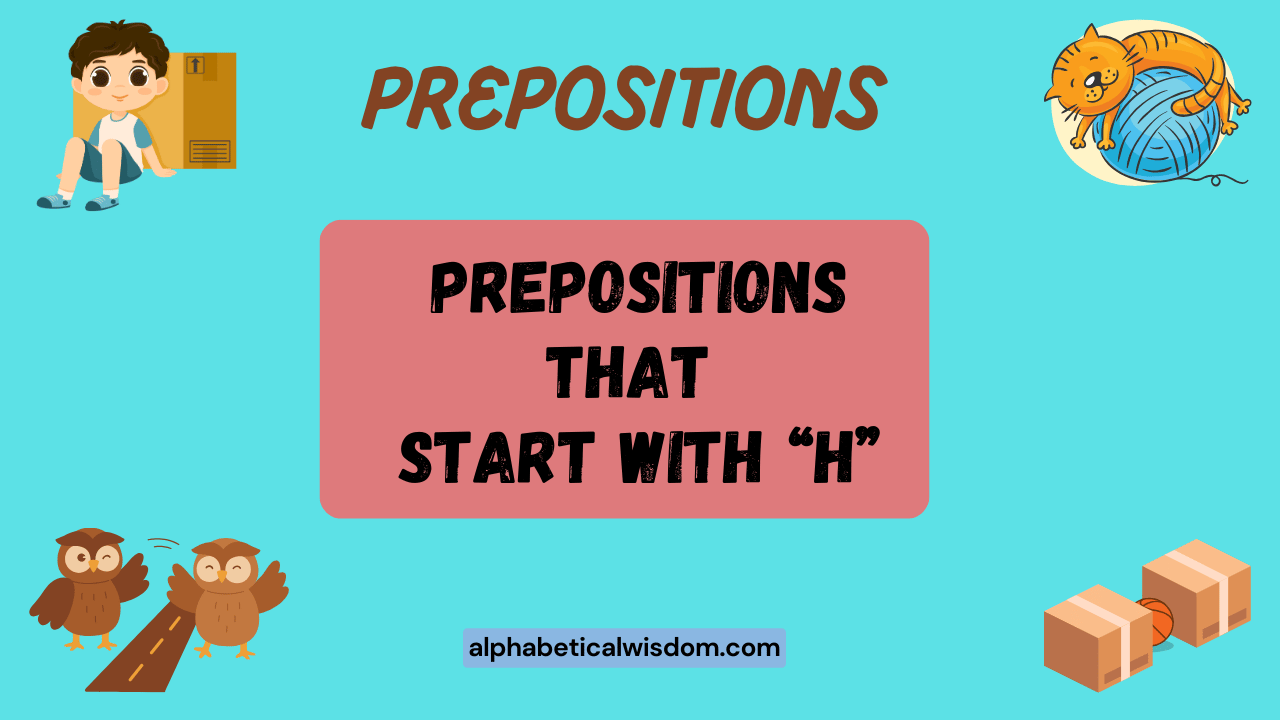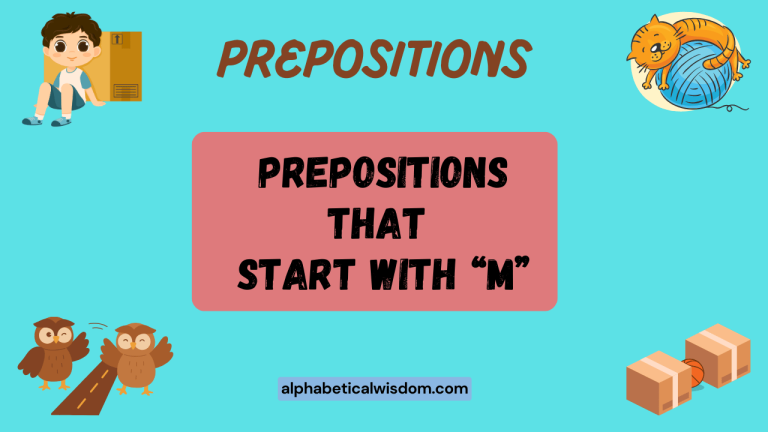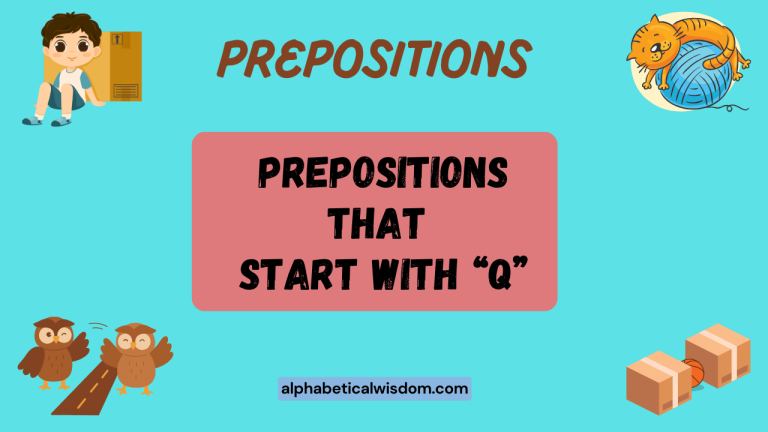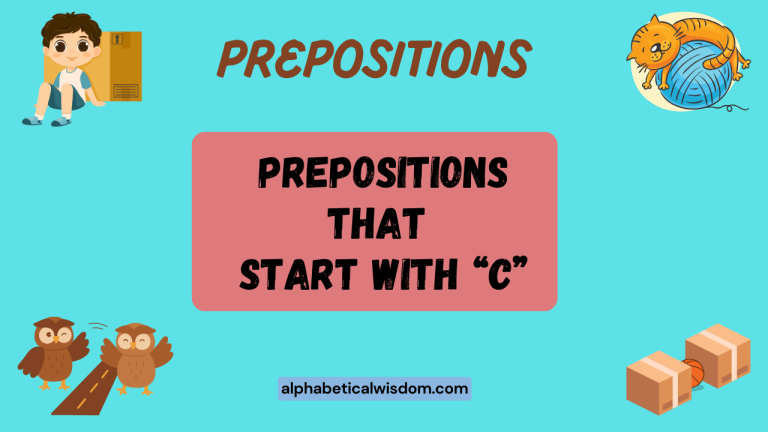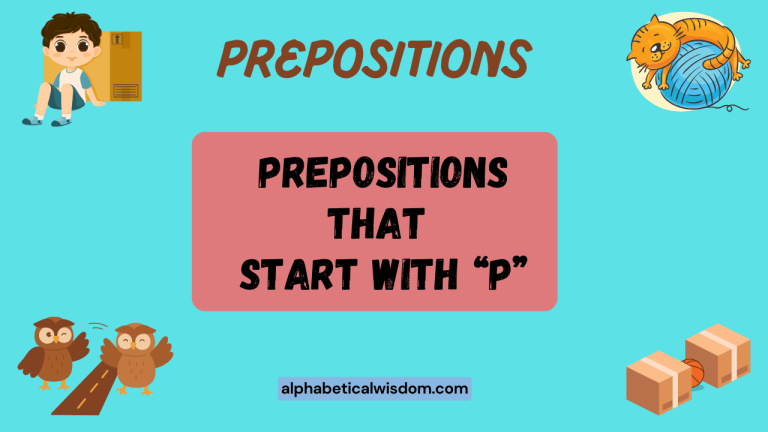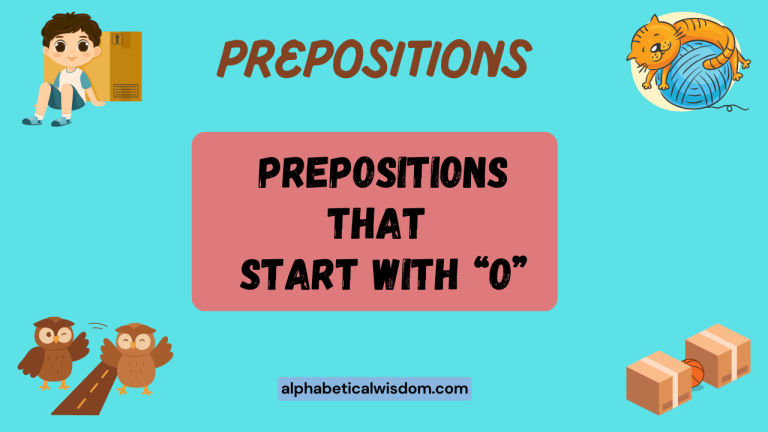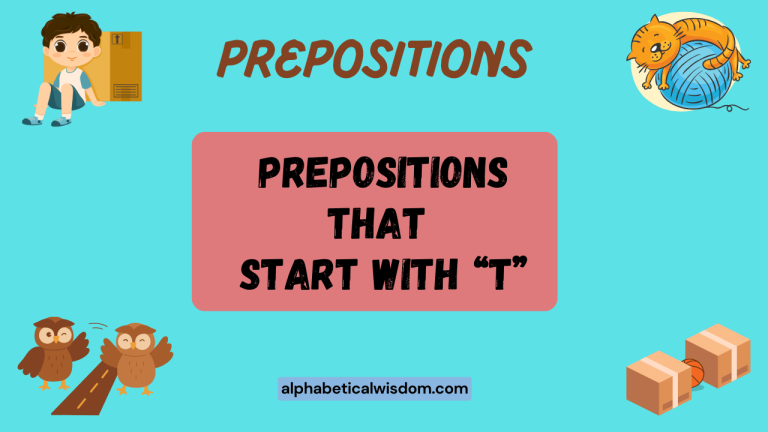Prepositions Starting With ‘H’: A Comprehensive Guide
Prepositions are essential components of English grammar, linking nouns, pronouns, and phrases to other parts of a sentence. Mastering prepositions enhances clarity and precision in communication.
This article focuses on prepositions that begin with the letter ‘H,’ exploring their meanings, usage, and common pitfalls. This guide is designed for English language learners of all levels, from beginners seeking foundational knowledge to advanced speakers aiming to refine their grasp of nuanced prepositional usage.
Table of Contents
- Introduction
- Definition of Prepositions
- Structural Breakdown of Prepositional Phrases
- Types of Prepositions Starting with ‘H’
- Examples of Prepositions Starting with ‘H’
- Usage Rules for Prepositions Starting with ‘H’
- Common Mistakes with Prepositions Starting with ‘H’
- Practice Exercises
- Advanced Topics
- FAQ
- Conclusion
Definition of Prepositions
A preposition is a word that connects a noun, pronoun, or noun phrase to another part of the sentence to show location, direction, time, or relationship. Prepositions typically precede a noun or pronoun, forming a prepositional phrase.
These phrases act as adjectives or adverbs, adding detail and context to sentences. Understanding prepositions is crucial for constructing grammatically correct and meaningful sentences.
Prepositions can be classified based on their function and the relationship they express. Common categories include prepositions of time (e.g., at, on, in), prepositions of place (e.g., above, below, beside), and prepositions of direction (e.g., to, from, toward). The prepositions starting with ‘H’ are relatively few in number but play specific roles in expressing relationships and conditions.
Structural Breakdown of Prepositional Phrases
A prepositional phrase consists of a preposition followed by its object, which is typically a noun or pronoun. The object of the preposition is the noun or pronoun that the preposition relates to another part of the sentence.
The entire prepositional phrase functions as a single unit, modifying either a noun (adjectival phrase) or a verb, adjective, or adverb (adverbial phrase).
The basic structure of a prepositional phrase is: Preposition + (Optional Modifiers) + Object. For example, in the phrase “by the river,” “by” is the preposition, “the” is a modifier, and “river” is the object. These phrases add crucial details to sentences, specifying location, time, manner, or other relevant information.
Consider the sentence, “The book is on the table.” Here, “on” is the preposition, and “the table” is the object of the preposition. The entire phrase “on the table” functions as an adverbial phrase, modifying the verb “is” and indicating the location of the book.
Types of Prepositions Starting with ‘H’
There are only a few prepositions that start with the letter ‘H’. The most common and important one is: Here. While “here” is more frequently used as an adverb, it can function as a preposition in specific, often archaic or dialectal contexts. Let’s understand its usages better.
Here (archaic)
The preposition “here” is rarely used in modern English, but historically, it could indicate location or proximity. Its usage is largely confined to older texts or specific regional dialects.
It implies a sense of presence or immediate vicinity.
Modern usage typically replaces “here” as a preposition with other prepositions such as “at,” “in,” or “near,” depending on the context. For instance, instead of saying “He stood here the door,” we would say “He stood at the door.”
Examples of Prepositions Starting with ‘H’
While the preposition “here” is rarely used in modern English, understanding its historical context and potential usage is valuable. The following examples illustrate how “here” might have been used as a preposition in older or more regional contexts.
Note that in contemporary English, alternative prepositions are generally preferred.
Examples of “Here” (Archaic/Dialectal)
The following table provides examples of how “here” might have been used as a preposition in older or dialectal English, along with more common modern alternatives.
| Archaic/Dialectal Usage | Modern Equivalent | Explanation |
|---|---|---|
| He dwelled here the forest. | He dwelled in the forest. | “Here” indicates location within the forest. |
| She waited here the gate. | She waited at the gate. | “Here” indicates a specific location at the gate. |
| They met here the crossroads. | They met near the crossroads. | “Here” implies proximity to the crossroads. |
| The village lies here the hill. | The village lies by the hill. | “Here” suggests the village is situated close to the hill. |
| He rested here the stream. | He rested beside the stream. | “Here” indicates a location next to the stream. |
| The treasure is buried here the old oak. | The treasure is buried under the old oak. | “Here” suggests location beneath the oak. |
| The birds nested here the eaves. | The birds nested in the eaves. | “Here” indicates the location within the eaves. |
| She planted flowers here the wall. | She planted flowers along the wall. | “Here” suggests the flowers are planted next to the wall. |
| The children played here the meadow. | The children played in the meadow. | “Here” indicates the location within the meadow. |
| He built his house here the lake. | He built his house near the lake. | “Here” suggests the house is located close to the lake. |
| The travelers camped here the riverbank. | The travelers camped on the riverbank. | “Here” indicates the location on the riverbank. |
| The hikers paused here the mountain pass. | The hikers paused at the mountain pass. | “Here” suggests the location at the mountain pass. |
| The sheep grazed here the hillside. | The sheep grazed on the hillside. | “Here” indicates the location on the hillside. |
| The artist painted here the cliff edge. | The artist painted at the cliff edge. | “Here” suggests the location at the cliff edge. |
| The soldiers stood guard here the tower. | The soldiers stood guard at the tower. | “Here” indicates the location at the tower. |
| The dancers performed here the stage. | The dancers performed on the stage. | “Here” suggests the location on the stage. |
| The audience sat here the orchestra. | The audience sat near the orchestra. | “Here” indicates the location near the orchestra. |
| The chef cooked here the open fire. | The chef cooked over the open fire. | “Here” suggests the location over the open fire. |
| The children gathered here the storyteller. | The children gathered around the storyteller. | “Here” indicates the location around the storyteller. |
| The students studied here the library. | The students studied in the library. | “Here” suggests the location within the library. |
| The workers labored here the construction site. | The workers labored at the construction site. | “Here” indicates the location at the construction site. |
| The athletes trained here the stadium. | The athletes trained in the stadium. | “Here” suggests the location within the stadium. |
| The scientists conducted research here the laboratory. | The scientists conducted research in the laboratory. | “Here” indicates the location within the laboratory. |
These examples illustrate how “here” could be used to indicate location, but it’s essential to remember that modern English typically employs alternative prepositions for clarity and common usage. The next section will elaborate on these modern usage rules.
Usage Rules for Prepositions Starting with ‘H’
As previously mentioned, “here” is rarely used as a preposition in contemporary English. Instead, prepositions like “at,” “in,” “near,” “by,” “on,” and others are more appropriate.
Understanding when to use these alternatives is crucial for effective communication.
Replacing “Here” with Modern Prepositions
The choice of preposition depends on the specific context and the relationship you want to express. Here’s a breakdown of common replacements for “here”:
- At: Use “at” for specific locations or points. Example: Instead of “She waited here the corner,” use “She waited at the corner.”
- In: Use “in” for enclosed spaces or general areas. Example: Instead of “He worked here the office,” use “He worked in the office.”
- Near: Use “near” to indicate proximity. Example: Instead of “The store is here the bank,” use “The store is near the bank.”
- By: Use “by” to indicate being next to something. Example: Instead of “The house is here the river,” use “The house is by the river.”
- On: Use “on” to indicate being on a surface. Example: Instead of “The book is here the table,” use “The book is on the table.”
- Under: Use “under” to indicate something is located beneath something else. Example: Instead of “The cat is here the table,” use “The cat is under the table.”
- Around: Use “around” to indicate something encircles or surrounds something else. Example: Instead of “The children sat here the campfire,” use “The children sat around the campfire.”
Consider these examples to further clarify the appropriate use of modern prepositions in place of the archaic “here”:
| Original Sentence (Archaic) | Revised Sentence (Modern) | Explanation |
|---|---|---|
| The meeting will be held here the town hall. | The meeting will be held at the town hall. | “At” specifies a particular location. |
| The children are playing here the park. | The children are playing in the park. | “In” indicates an enclosed area. |
| The restaurant is here the movie theater. | The restaurant is near the movie theater. | “Near” shows proximity. |
| She sat here the window. | She sat by the window. | “By” indicates being next to something. |
| The flowers are here the vase. | The flowers are in the vase. | “In” indicates containment. |
| The dog is sleeping here the rug. | The dog is sleeping on the rug. | “On” indicates being on a surface. |
| The cat hid here the bed. | The cat hid under the bed. | “Under” indicates being beneath something. |
| They gathered here the old tree. | They gathered around the old tree. | “Around” indicates encircling something. |
By understanding these distinctions, you can avoid using “here” as a preposition and choose the most accurate and appropriate preposition for your intended meaning. This will improve the clarity and correctness of your English.
Common Mistakes with Prepositions Starting with ‘H’
Because “here” is rarely used as a preposition in modern English, the most common mistake is using it instead of a more appropriate preposition. Recognizing and correcting this error is essential for clear and accurate communication.
Here’s a breakdown of common mistakes and their corrections:
| Incorrect Sentence | Correct Sentence | Explanation |
|---|---|---|
| They waited here the bus stop. | They waited at the bus stop. | “At” is used for specific locations. |
| She studied here the library. | She studied in the library. | “In” is used for enclosed spaces. |
| The cafe is here the post office. | The cafe is near the post office. | “Near” indicates proximity. |
| He sat here the fireplace. | He sat by the fireplace. | “By” indicates being next to something. |
| The picture is here the wall. | The picture is on the wall. | “On” indicates being on a surface. |
| The children played here the garden. | The children played in the garden. | “In” is used for enclosed spaces. |
| The dog slept here the table. | The dog slept under the table. | “Under” indicates being beneath something. |
| The family gathered here the Christmas tree. | The family gathered around the Christmas tree. | “Around” indicates encircling something. |
| The cat is sitting here the windowsill. | The cat is sitting on the windowsill. | “On” indicates being on a surface. |
| The students are waiting here the classroom. | The students are waiting in the classroom. | “In” is used for enclosed spaces. |
Another common mistake involves confusion with the adverb “here,” which indicates a place but does not connect a noun or pronoun to another part of the sentence. For example:
| Incorrect Sentence | Correct Sentence | Explanation |
|---|---|---|
| Here the park is beautiful. | In the park, it is beautiful. The park here is beautiful. |
“Here” as an adverb should not replace a preposition. |
| Here the shop, you can find everything. | At the shop, you can find everything. The shop here has everything. |
“Here” as an adverb is different from a preposition. |
By being aware of these common mistakes and understanding the correct usage of alternative prepositions, you can significantly improve the accuracy of your English and avoid confusion.
Practice Exercises
Test your understanding of prepositions that start with ‘H’ (and their modern equivalents) with the following exercises. Choose the correct preposition to complete each sentence.
Exercise 1: Choose the Correct Preposition
| Question | Options | Answer |
|---|---|---|
| The book is ______ the table. | a) here b) on c) in | b) on |
| She waited ______ the corner. | a) here b) at c) in | b) at |
| He worked ______ the office. | a) here b) in c) on | b) in |
| The store is ______ the bank. | a) here b) near c) on | b) near |
| The house is ______ the river. | a) here b) by c) in | b) by |
| The cat is sleeping ______ the rug. | a) here b) on c) under | b) on |
| The hidden treasure is ______ the ground. | a) here b) under c) on | b) under |
| The children are playing ______ the garden. | a) here b) in c) at | b) in |
| The painting is displayed ______ the wall. | a) here b) on c) near | b) on |
| The students are studying ______ the library. | a) here b) in c) near | b) in |
Exercise 2: Rewrite Sentences Using Modern Prepositions
Rewrite the following sentences, replacing the archaic “here” with a more appropriate modern preposition.
| Original Sentence | Corrected Sentence |
|---|---|
| They met here the crossroads. | They met at the crossroads. |
| She sat here the window. | She sat by the window. |
| The bird nested here the eaves. | The bird nested in the eaves. |
| The travelers camped here the riverbank. | The travelers camped on the riverbank. |
| The chef cooked here the open fire. | The chef cooked over the open fire. |
| The children played here the meadow. | The children played in the meadow. |
| He is hiding here the table. | He is hiding under the table. |
| The family gathered here the fireplace. | The family gathered around the fireplace. |
| She placed the vase here the shelf. | She placed the vase on the shelf. |
| The students waited here the bus stop. | The students waited at the bus stop. |
Advanced Topics
For advanced learners, it’s helpful to understand the historical context of “here” as a preposition and its connection to other Germanic languages. Additionally, exploring the nuances of prepositional usage in complex sentences can further refine your understanding.
Historical Context of “Here”
The use of “here” as a preposition is a remnant of older English and related Germanic languages, where adverbs and prepositions were more interchangeable. Over time, English has evolved to favor distinct prepositions for clarity and precision.
Studying Old English or Middle English texts can provide insights into the historical usage of “here” and its gradual decline as a preposition.
Prepositional Usage in Complex Sentences
In complex sentences, prepositional phrases can become more intricate, requiring careful attention to ensure correct placement and meaning. Mastering the use of multiple prepositional phrases within a single sentence can significantly enhance your writing skills.
For example:
“The book on the table near the window belongs to the student in the blue shirt.”
In this sentence, each prepositional phrase modifies a different element, adding layers of detail and specificity. Understanding how these phrases interact is crucial for advanced comprehension and expression.
FAQ
- Is “here” ever used as a preposition in modern English?
While extremely rare, “here” might be used as a preposition in some very specific regional dialects or archaic contexts. However, it is generally avoided in modern standard English in favor of more precise prepositions such as “at,” “in,” “near,” or “by.”
- What is the difference between the adverb “here” and the preposition “here”?
The adverb “here” indicates a place but does not connect a noun or pronoun to another part of the sentence. For example, “Come here!” The preposition “here,” though archaic, would connect a noun or pronoun to another part of the sentence to show location or relationship, similar to “at” or “in.”
- Why is it important to avoid using “here” as a preposition?
Using “here” as a preposition in modern English can sound awkward and confusing to native speakers. It is best to use more common and precise prepositions to ensure clarity and avoid miscommunication.
- How do I choose the correct preposition to replace “here”?
The choice of preposition depends on the specific context. Consider the relationship you want to express (location, proximity, containment) and choose the preposition that best conveys that meaning. “At” for specific locations, “in” for enclosed spaces, “near” for proximity, and “by” for being next to something are common replacements.
- Can you give an example of a sentence where “here” is used correctly as an adverb?
Yes, for example: “The park is beautiful here.” In this sentence, “here” modifies the verb “is” and indicates the location of the park. It does not connect a noun or pronoun to another part of the sentence.
- Are there any exceptions to the rule of not using “here” as a preposition?
The only exceptions are in very specific regional dialects or when intentionally trying to evoke an archaic style. In general conversation and formal writing, you should avoid using “here” as a preposition.
- What are some other prepositions that are commonly misused?
Other commonly misused prepositions include “on,” “in,” “at,” “to,” and “from.” These prepositions can be tricky because their usage depends on the specific context and the relationship you want to express. Pay close attention to the rules and practice using them in different sentences.
- Where can I find more resources to learn about prepositions?
There are many excellent resources available online and in libraries. Grammar websites, textbooks, and online courses can provide comprehensive explanations and practice exercises to help you master prepositions. Additionally, reading widely and paying attention to how native speakers use prepositions can be very beneficial.
- How can I improve my understanding of prepositions in general?
Practice, practice, practice! The more you read, listen, and write in English, the more you will internalize the correct usage of prepositions. Pay attention to the context in which prepositions are used and try to identify patterns and rules. Don’t be afraid to ask questions and seek feedback from native speakers or teachers.
- Is there a definitive list of all prepositions in English?
While there is no single, universally agreed-upon list, resources generally cite between 70 and 150 prepositions in the English language. This variation arises due to the categorization of certain words and phrases that can function prepositionally depending on context.
Conclusion
Understanding prepositions is essential for mastering English grammar. While “here” is rarely used as a preposition in modern English, recognizing this and using appropriate alternatives like “at,” “in,” “near,” and “by” will significantly improve the clarity and accuracy of your communication.
By studying examples, practicing exercises, and being aware of common mistakes, you can confidently navigate the complexities of prepositional usage.
Remember to focus on context and meaning when choosing prepositions. Pay attention to how native speakers use them and don’t hesitate to ask for clarification when needed.
Continued practice and attention to detail will help you master prepositions and enhance your overall fluency in English.
